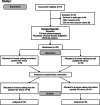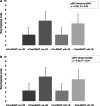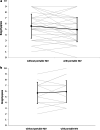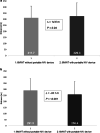Portable NIV for patients with moderate to severe COPD: two randomized crossover trials
- PMID: 33902562
- PMCID: PMC8074437
- DOI: 10.1186/s12931-021-01710-2
Portable NIV for patients with moderate to severe COPD: two randomized crossover trials
Abstract
Background: Long-term non-invasive ventilation (NIV) is as an established treatment option for chronic hypercapnic COPD patients. Beneficial effects have also been shown during exercise, but this is restricted to rehabilitation programs. New portable NIV (pNIV) devices may now enable NIV application during walking at home.
Study design and methods: In two randomized crossover trials, the impact of pNIV on dyspnea and endurance capacity was investigated in patients with moderate to severe COPD. Participants performed a standardized 6-min walking test, with and without pNIV, using a pre-set inspiratory/expiratory positive airway pressure of 18/8 cmH2O. The first study was performed in NIV-naïve patients (Study I), while the second study was performed in those already established on long-term NIV (Study II).
Results: 38 patients (66.9 ± 7.4 years, mean FEV1: 30.3 ± 8%pred) and 23 patients (67.6 ± 8.7 years, mean FEV1: 29.8 ± 10.4%pred) participated in Study I and II, respectively. In Study I, the mean difference in the Borg Dyspnea Scale (BDS, primary outcome) score following walking was 3.2 (IQR 2-4) without pNIV, compared to 2.6 (IQR 1-4) with pNIV (ΔBDS 0.65, P = 0.04), while walking distance increased from 311.8 m (95%CI 276.9-346.6 m) to 326.3 m (95%CI 291.5-361.2 m) (P = 0.044) when pNIV was used. Accordingly, in Study II, the mean difference in BDS was 4.4 (IQR 3-6) without pNIV, compared to 4.5 (IQR 3-6) with pNIV (ΔBDS 0.09, P = 0.54), while walking distance decreased from 291.5 m (95%CI 246.1-336.9 m) to 258.4 m (95%CI 213-303.8 m) (P ≤ 0.001).
Interpretation: The use of a pNIV device during walking can improve dyspnea and walking distance in patients with moderate to severe COPD. Patients who do not already receive long-term NIV therapy are more likely to benefit compared to those undergoing long-term NIV. Careful patient selection is mandatory. Clinical Trial Register: DRKS00013203; DRKS00012913 registered October 20th 2017 and October 16th 2017; https://www.drks.de/drks_web/.
Keywords: COPD; Endurance capacity; Non-invasive ventilation; Respiratory insufficiency.
Conflict of interest statement
DSM: open research grant from Philips Respironics/USA. FSM received speaking fees from companies dealing with mechanical ventilation products. ST: no conflicts of interest. CS: no conflicts of interest. WW: received speaking fees from companies dealing with mechanical ventilation products. SBS: received travel grants from companies dealing with mechanical ventilation products. The Cologne study group (DSM, SBS, FSM and WW) received open research grants from Weinmann/Germany, Vivisol/Germany, Heinen und Löwenstein/Germany, VitalAire/Germany, and Phillips Respironics/USA.
Figures






References
-
- Ergan B, Oczkowski S, Rochwerg B, Carlucci A, Chatwin M, Clini E, Elliott M, Gonzalez-Bermejo J, Hart N, Lujan M, Nasilowski J, Nava S, Pepin JL, Pisani L, Storre JH, Wijkstra P, Tonia T, Boyd J, Scala R, Windisch W. European Respiratory Society guidelines on long-term home non-invasive ventilation for management of COPD. Eur Respir J. 2019 doi: 10.1183/13993003.01003-2019. - DOI - PubMed
-
- Windisch W, Geiseler J, Simon K, Walterspacher S, Dreher M, on behalf of the Guideline C German national guideline for treating chronic respiratory failure with invasive and non-invasive ventilation—revised edition 2017: part 2. Respiration. 2017;2018(96):171–203. - PubMed
-
- Windisch W, Geiseler J, Simon K, Walterspacher S, Dreher M, on behalf of the Guideline C German national guideline for treating chronic respiratory failure with invasive and non-invasive ventilation: revised edition 2017—part 1. Respiration. 2017;2018(96):66–97. - PubMed
Publication types
MeSH terms
LinkOut - more resources
Full Text Sources
Medical

